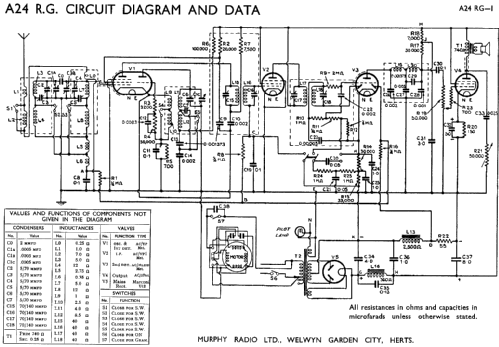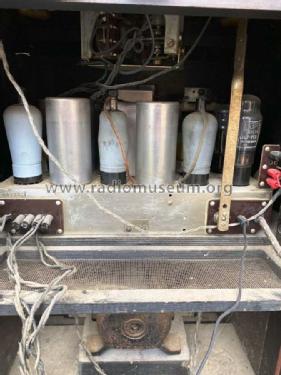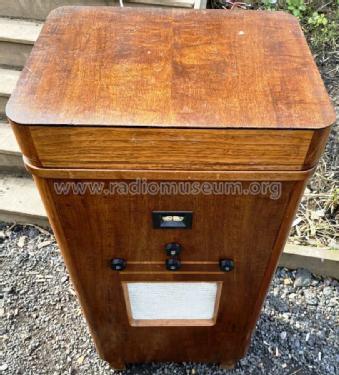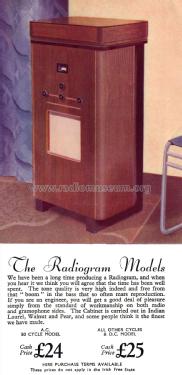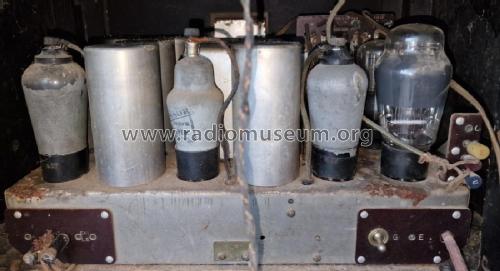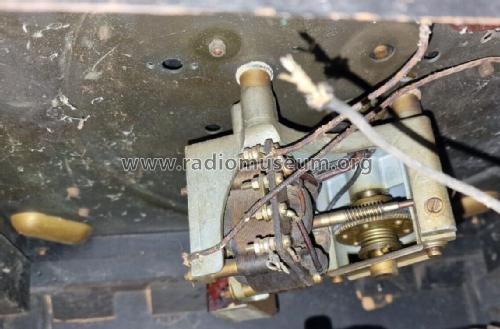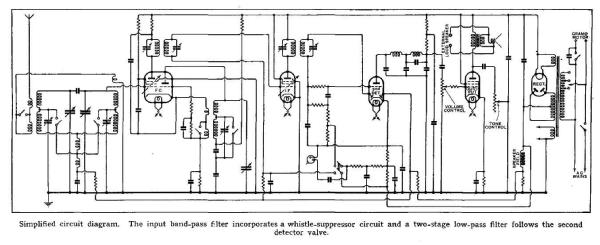Radiogram A24RG
Murphy Radio Ltd.; Welwyn Garden City
- Produttore / Marca
- Murphy Radio Ltd.; Welwyn Garden City
- Anno
- 1934
- Categoria
- Radio (o sintonizzatore del dopoguerra WW2)
- Radiomuseum.org ID
- 129798
Clicca sulla miniatura dello schema per richiederlo come documento gratuito.
- Numero di tubi
- 5
- Principio generale
- Supereterodina (in generale); ZF/IF 117 kHz
- N. di circuiti accordati
- 7 Circuiti Mod. Amp. (AM)
- Gamme d'onda
- Onde medie (OM) e onde lunghe (OL).
- Particolarità
- Giradischi (non cambiadischi)
- Tensioni di funzionamento
- Alimentazione a corrente alternata (CA) / 200-250 Volt
- Altoparlante
- AP elettrodinamico (bobina mobile e bobina di eccitazione/di campo)
- Materiali
- Mobile in legno
- Radiomuseum.org
- Modello: Radiogram A24RG - Murphy Radio Ltd.; Welwyn
- Forma
- Console, con gambe d'appoggio basse (< 50%).
- Annotazioni
-
5-valve superheterodyne AC-powered radiogram.
MW and LW radio and a manual 78rpm turntable.
Features:-
- Triode-pentode frequency changer
- Variable-mµ pentode IF amplifier
- Duo-diode-triode second detector
- Pentode output valve
- Large BTH loudspeaker
- Controls. Tuning, Volume, Tone, Wavechange and on-off switch, Radiogram switch,
The cabinet is in Indian Laurel, Walnut, and Pear in a modernistic style by R.D. Russell.
A similar chassis is fitted to the Murphy A24 table radio and the Murphy A24 console radio.
An AC mains 100 volt 25 c/s version is also available at £1 extra and also a DC version at £27.
Special filters: -
The aerial is coupled to the grid of V1 by a bandpass tuning circuit which also incorporates an image frequency suppression circuit (whistle suppressor). Additionally in the anode circuit of V3 is a heterodyne filter with a very sharp cut-off.
- Prezzo nel primo anno
- 24.00 £
- Letteratura / Schemi (1)
- -- Schematic
- Letteratura / Schemi (2)
- Trader Service Sheet (suppl. of Wireless & El. Trader, etc.) (635 dated August 28 1943)
- Letteratura / Schemi (3)
- Wireless World (The), London (WW, 79) (February 1st, 1935. Page 120 & 121)
- Autore
- Modello inviato da un iscritto da D. Utilizzare "Proponi modifica" per inviare ulteriori dati.
- Altri modelli
-
In questo link sono elencati 367 modelli, di cui 301 con immagini e 235 con schemi.
Elenco delle radio e altri apparecchi della Murphy Radio Ltd.; Welwyn Garden City
Discussioni nel forum su questo modello: Murphy Radio Ltd.;: Radiogram A24RG
Argomenti: 1 | Articoli: 1
MURPHY RADIOGRAMOPHONE MODEL A24 RG
A Cabinet of Outstanding Acoustic Design
There is a tendency in some quarters to assume that a radiogramophone must of necessity be an “imposing piece of furniture" Underlying this assumption is the belief that to command ready sales the impression must be created that one is receiving “a lot of set for a little money.” Consequently, it is common to find many low-priced radio gramophones in which only a small proportion of the interior volume is occupied by the chassis and loudspeaker. The remaining empty space in conjunction with the thin three-ply walls of the cabinet form an evil alliance for the production of bass resonances.
It is because of this long-standing convention in cabinet design that the first comment of most people on becoming acquainted with the Murphy Radiogramophone is related to its comparatively small size. Actually, the dimensions are approximately 39in. X 19in. X 15in., the area of the top being dictated, of course, by the size of the gramophone turntable. The designers decided, however, that these dimensions gave a depth of cabinet from back to front which was far from ideal from the acoustic point of view, and the cabinetmaker's solution, though unconventional, is undeniably practical and at the same time agreeable to the eye when the cabinet is viewed, as it normally is, from the front.
Solid Construction
Not content with reducing the depth of the cabinet, and supporting the overhang at the back by pillars, the makers have reinforced the side and front panels with thick Celotex sound-absorbing material, and in addition, the back and base of the cabinet are left entirely open. Walnut and Indian laurel are the woods employed, and the generous scantlings of the component members give an extremely rigid assembly. The front panel is relieved with pearwood inlays and the finish is matt.
A large B.T.H. energised loudspeaker is employed, and the results from the point of view of the quality of reproduction amply justify the precautions which have been taken in the design of the cabinet. There is not the least trace of cavity or wood resonance, and at first, the reproduction appears to be deficient in bass. This is only because the ear has become accustomed to bass resonance in commercial receivers of all kinds, and after a time the true quality of the bass becomes apparent. There appears, however, to be some masking of the bass by a rather over-generous response in the region of 2,500 and 3,500 cycles, but this is easily corrected with the tone control. The top cut-off is at 5,000 cycles, and this has been made sharp by a specially designed filter preceding the output stage. The cutoff frequency has been happily chosen, as it permits the reproduction of most of the frequencies which are to be found on modern recordings and at the same time eliminates the pick-up resonance and which it most of the needle scratch.
The pick-up is of the needle armature type, and the gramophone motor has a higher torque than usual to ensure freedom from pitch variation on loud passages. The motor-board is flush-mounted to facilitate the removal of the needles should they be dropped accidentally, and the needle cups, as well as the inside of the lid, are lined with felt to avoid the possibility of rattles. The amplification succeeding the pickup has been carefully adjusted to ensure that with the volume control at maximum overloading of the output stage and loudspeaker is avoided.
On the radio side, the chassis of the A24 receiver is employed with minor modifications. The frequency changer is a triode - pentode preceded by a band-pass input filter incorporating a second channel whistle suppressor. Both the frequency changer and the IF amplifier are controlled by amplified AVC bias, and the set is silenced when using the gramophone by over- biasing these valves. The low pass filter in the anode circuit of the triode portion of the second detector functions both on radio and gramophone, as do the volume and tone controls associated with the pentode output valve. Both wavebands are free from self-generated heterodyne whistles, and there is little doubt that the sensitivity is as high as it can be made with a four-stage superheterodyne circuit.
The selectivity is sufficient to give clear reception of the Deutschlandsender on long waves except for occasional side-band interference from Droitwich and Radio -Paris on deeply modulated passages. On the medium waveband, only one channel was lost on either side of the Brookmans Park transmitters with the receiver operating in Central London. Incidentally, it was noted that the selectivity was unusually uniform over the medium waveband. The automatic volume control works well, and in London, there is no perceptible change in volume when the receiver is tuned successively to the North and Midland transmitters and only a slight increase when tuned to London Regional the manual volume control being untouched, of course.
To sum up, the makers have succeeded in producing a solid and compact instrument, in which the bugbear of cabinet resonance has been completely eliminated. The reproduction, particularly on gramophone records, reaches a very high standard, and the radio performance is capable of bringing in all the foreign programs which are likely to be of the slightest program value. The set is easy to handle, and the effective automatic volume control relieves the operator of the necessity of continual manipulation of the hand volume control.
Models are available for AC mains at frequencies other than 50 cycles at an additional cost of £1, while there is also a DC version at £27.
Wireless World, February 1st, 1935. Page 120 & 121
Gary Cowans, 24.Feb.22
